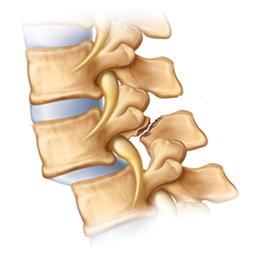The spondylolisthesis, it's an intimidating word at first glance, but all you have to do is divide it into 4 sections: es – pon – dilo – listesis. So it is not so difficult to pronounce it.
That is why this medical condition is often abbreviated as “listesis”. It is also not that difficult to understand if you think that the term comes from Greek roots: espóndilo significa “vertebra” y listesis significa “deslizarse”.
Spondylolisthesis occurs when a vertebra slides forward over the lower vertebra.
More often, this occurs in the lower back (lumbar area), as it is a part of the spine that supports a great deal of weight and absorbs a great deal of directional pressure.
In other words, the lumbar spine has to move a little (rotate in various directions) with body weight.
Sometimes, this combination can put so much emphasis on the vertebrae that one of them slides forward.
Some activities make you more susceptible to spondylolisthesis. Gymnasts, the football players, and weightlifters all put significant pressure and weight on their lower backs.
Think about the gymnasts and the positions in which they put their body: they practically fold back in half, that something extreme that can be harmful to the vertebral.
They also squirm in the air quickly when doing cartwheels and then fall to the ground., absorbing shock through your legs and lower back.
Those movements put substantial strain on the spine, and spondylolisthesis can develop as a result of repeated excessive strains and stress..
Doctors have 5 different grades to measure spondylolisthesis, depending on the distance the vertebra has slid forward.
Durante tu cita con el médico es posible que le escuches hablar de “un grado de espondilolistesis”. Something that you can discover later.
Index
Signs and tests to diagnose spondylolisthesis
It's hard to tell if someone has spondylolisthesis, because you may not have any symptoms or crushing pain - as most people do.
Spondylolisthesis is usually discovered when studies are being done for something else and the doctor or radiologist, notice that a vertebra appears displaced on an x-ray.
X-rays are the best way to diagnose spondylolisthesis. During the x-ray, probably standing, taken sideways, is when the doctor can get a side view, more clearly show slippage.
Regarding the upper radiography, you can see that one of the vertebrae has slipped out of the spine. Arrow points to spondylolisthesis.
Your doctor may also order an oblique X-ray.. Oblique means that the X-ray is taken at an angle from the back, a view to help the doctor see the slide, articular veneers, and interarticular parts.
To know if your spondylolisthesis is unstable and mobile, the doctor may ask you to do push-ups and extensions viewed from the side. These are also called lateral bending views.
A flexion x-ray is taken with the patient leaning forward; an extension x-ray is taken when bending backwards.
To have a better confirmation of spondylolisthesis, the patient may need to undergo a CT scan.
If the displaced vertebra is pressing on the nerves, the doctor may order a myelogram. In this test, a special dye is required, which is injected into the area around the nerves that are in a sac so that the tincture enters that sac (before that happens, The area will be numbed.).
An X-ray or CT scan may then be done.. The result will provide a detailed anatomical image of the spine, especially from the bones, to help your doctor identify any abnormalities.
Part of your visit to the doctor will include physical and neurological exams. On physical exam, your doctor will take your posture into account, range of motion (how well and how far certain joints can move), and physical condition, observing any movement that causes pain.
The doctor will feel your spine, taking into account your curvature, the alignment, and the sensation of muscle spasms. Spondylolisthesis can cause you to walk abnormally, so the doctor will have to observe you while you walk.
During the neurological exam, the spine specialist will test your reflexes, muscle strength, and other nerve changes, as well as the spread of pain (that is to say, if he back pain travels to other parts of your body).
Physical and neurological exams will give your doctor a good idea of how the displaced vertebra is affecting your body and your life..
Slip degrees
Using lateral radiographs, the doctor will rate your spondylolisthesis. Using a scale starting with "Grade I" and progressing to "Grade V" they describe how far forward your vertebra has slipped.
Grade I is a slip of less than 25 %.
Grade II is a slip of the 25 % al 50 %.
Grade III is a slip of the 50 % al 75 %.
Grade IV is a slip of the 75 % al 100 %.
Grado V is for a vertebra that has fallen off the lower vertebra. (That is an extreme case of spondylolisthesis., which has its own name: Spondyloptosis)
